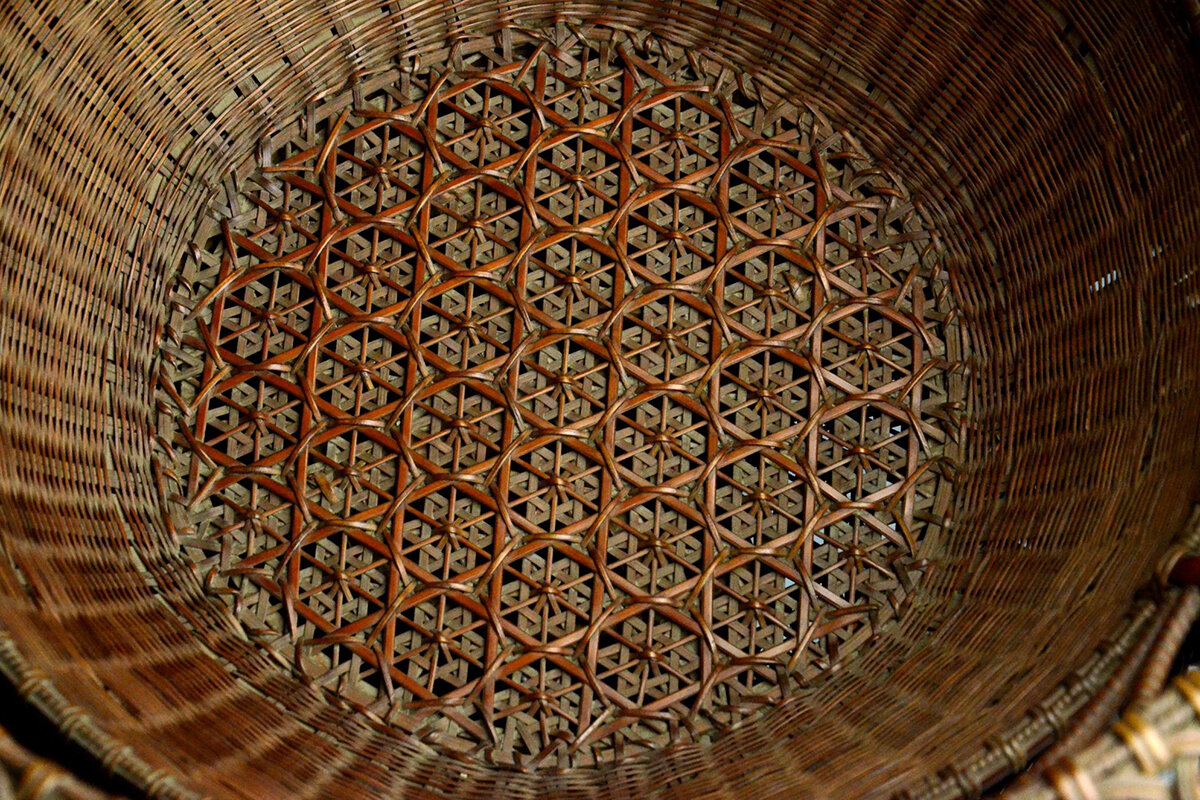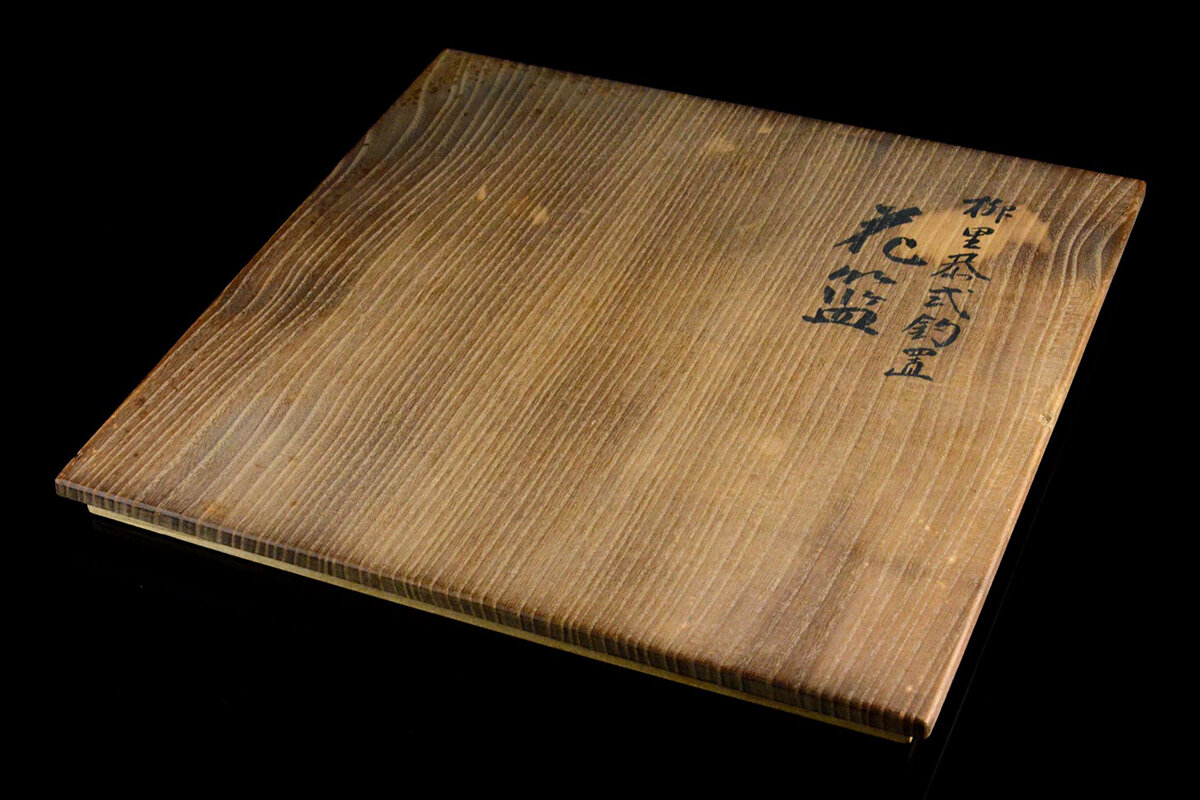BASKETRY
TANABE CHIKUUNSAI I, HANGING FLOWER BASKET IN THE STYLE OF YANAGISAWA RYURIKYO
Flower arranging basket in an openwork, flaring form with a loop style handle. Oven of split, smoked bamboo and rattan. Signed on the reverse with an incised signature by the artist: Chikuunsai Kore wo Tsukuru or Made by Chikuunsai (Tanabe Chikuunsai I, 1877 – 1937). Late Meiji – Taisho era, circa 1900 – 1920.
With the tomobako or original box, inscribed on the exterior of the lid: Ryurikyo Tsuri-ki Hana-kago or (Yanagisawa) Ryurikyo (style) Hanging Flower Basket (meaning that the piece is in the style of Yanagisawa Ryurikyo or Yanagisawa Kien (1703 – 1758), the distinguished, mid-Edo period kanshi poet and painter famous for his depictions of hanging flower baskets); and on the reverse of the lid signed: Sakai Fu Nanso, Chikuunsai Kore wo Tsukuru or Sakai City, In a House Facing South, Made by Chikuunsai, and sealed twice.
Made to be displayed with flowers either hanging or set in a tokonoma, this elaborately woven basket parallels a small number of pieces by Chikuunsai I from early in the century. While a number of open-work baskets with this profile were made by Chikuunsai I and his son (c.f. Japanese Bamboo Baskets: Masterworks of Form & Texture from the Collection of Lloyd Cotsen, number 82), a more apt comparison exists with numbers 80, and especially 82 in the same catalogue. Filigree ropes, openwork windows, and elaborate ornamental knotting detail these extraordinary baskets.
Chikuunsai builds a hemispherical form, with an everted, flaring rim. Two handle sections arc over the top, finished in diagonal simple wrapping (bo-maki). Lines of insect wrapping (mushi-maki) anchor them to the inner rim. Six ornamental, double interlocking V knots (kunoji-musubi) bind the handle pieces together, flanking a central suspension loop of simple wrapping at the top.
A horizontal shelf encircles the rim, framed from two circles of rattan linked by repeating traceries of doubled rattan. Simple wrapping (bo-maki) holds the rattan loops to the inner rim, while repeating, ornamental double V knots (kunoji-musubi) bind them on the outer (and echo the handle knotting).
Between this upper-rim shelf and the solid edge of the body slopes a pierce-work space filled with ovals and circles. Simple wrapping covers the circular openings; tightly curled, finely cut stays of bamboo make the horizontal ovals (stacked or curled to four layers each). Undulating lines of simple wrapping support this fenestration at top and bottom, while double strands of simple wrapping link the circles to the ovals and each to the undulating lines.
Six smoked bamboo stays rise from the base to the upper-rim shelf. These overlay the exterior face of the body, then pass through the open fretwork to the rim. In the window, another section of smoked bamboo backs them on the interior, so that only the satin skin of the bamboo shows within and without. Ornamental double V knots tie them to the fenestration, with another central knot reinforcing the paired stays. Complex cross knots (juji-musubi) anchor these six stays to the lower rim.
Mat plaiting (gozame-ami) plaits the sides of the body. Between each of the long overlays that rise from the foot to the upper rim, seven additional stays overlay and rib the exterior of the basket. Bands of horizontal twining bind these stays to the body, located just below the lower rim and above the foot, with an additional double line at the center line. At the top of the body’s solid plaiting, another overlay of smoked bamboo cinches the waist, bound with repeating, double strands of simple wrapping. A line of stitched insect wrapping (kakemushi-maki) tops the upper band of twining.
Thunderbolt plaiting repeats around the outer section of the foot-ring. Just above this lies a beaded line of simple wrapping. The foot consists of three separate rings inset one within another. Simple wrapping coats the outer and middle ring, with four rattan bands binding the ends of the inner ring together. Heavy sections of bamboo cross the base, fit together by cut joinery, with curving buttress sections on each side of the crossing. Around this flies a circle of ornamental simple wrapping. The cross-piece supports the artist’s signature. Beneath the crossed bamboo structure (or above it if seen from below) lies an overlay of repeating diamond-plaited rattan, backed by the matte side of the hemp leaf pattern plaiting on the interior.
Looking into the well of the basket, one sees a layered, almost floral plaiting across the floor of the basket. Hemp leaf pattern weaving (asa-no-ha) executed in smoked bamboo and rattan overlays a repeating plait made up of six-pointed stars.
Employing a classical weaving idiom, Chikuunsai I went to great lengths with this flower basket. Ornamental knotting studs the surface, with an elaborate architecture of overlays, complex plaiting and pierce-work windows. That he made so few of this type may reflect the amount of time they required to create. One imagines that Chikuunsai was weaving with an audience in mind, perhaps for exhibition, perhaps for an important patron on commission.
Tanabe Chikuunsai I, Hanging Flower Basket in the Style of Yanagisawa Ryurikyo
Artist Name: Tanabe Chikuunsai I
Period: Meiji Taisho
Mediums: Bamboo
Form: Basket
Origin Country: Japan
33 cm high x 38 cm diameter (metric)
13” high x 15” diameter (inches)
This piece is no longer available.







